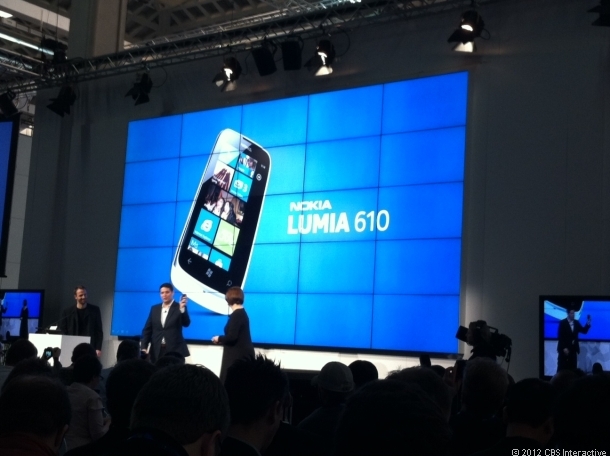Elop: Nokia is back on track

Nokia believes it is set to return to being a leading player in the smartphone world following a strong reception to its Asha and Lumia family of devices, according to the Finnish handset maker.

At Mobile World Congress in Barcelona, Nokia showed off the Lumia 610. Image credit: Kent German/CNET News
Alongside touting the company's return to form, Nokia introduced the Lumia 610 and the camera-centric Nokia 808 PureView smartphones at Mobile World Congress 2012 on Monday. The new Lumia adds a cheaper model to Nokia's Windows Phone OS-based line-up and provides a new entry point to Nokia's ranges.
"One year ago we said we would switch our strategy for smart devices to Windows Phone, we said we would connect one billion people to the internet using our mobile phones, and we would focus on key differentiators," Stephen Elop, chief executive of Nokia, told the MWC audience in Barcelona.
Elop delivered a damning assessment of the Finnish handset maker a year ago in a leaked memo, saying the once-dominant company had fallen "years behind" rivals such as Apple's iPhone, Google-backed Android and low-cost Chinese phones. In February 2011, it also announced a deal with Microsoft that would see it switch its focus to Windows Phone OS and phase out its Symbian OS work, as part of a push to deliver handsets to a tighter time frame.
Nokia's targets
In his MWC keynote speech, Elop re-iterated that not only is Nokia aiming high with its targets, but that it was striving to achieve them as quickly as possible by disseminating handsets into multiple markets, with multiple operators. He noted that the Lumia 710 and Lumia 800, launched late last year, are now available in 31 markets with more than 50 operators.
"One year later it's very, very clear that we have changed the clock speed of Nokia. In the last year alone, we launched the Asha family of products... Also in the last year, we introduced three new Lumia devices, ahead of schedule, establishing beachheads from which we will continue to expand and grow," Elop said.
In January, Nokia announced its re-entry into the US smartphone market with the Lumia 900, which has recently been a challenging country for Nokia to crack. However, Elop said sales in the US have "exceeded expectations" and that European consumers are "responding positively".
"Considering how long it's traditionally taken Nokia to change course, it is amazing to see what they achieved in a year. [There's] more to do of course," Gartner analyst Carolina Milanesi said in a post to Twitter.
On Monday, Nokia said it will start shipping the Lumia 900 to non-US markets, including the UK. In Europe, the 900 handset will not come with LTE, but will be a DC-HSPA variant instead. It will cost €480 (£406) and is expected to arrive in the second quarter.
In addition to talking up Nokia's progress, Elop introduced the Lumia 610 and Nokia 808 PureView, which has a huge 41-megapixel camera sensor. Nokia also launched three Symbian-based Asha handsets — the touchscreen Asha 202, 203 and a QWERTY-equipped Asha 302, to connect "the next one billion consumers", said Mary McDowell, head of mobile phones at the handset maker.
The Lumia 610 has a 3.7-inch screen, a 5-megapixel camera and 8GB of internal memory. Image credit: CNET UK
Lumia 610
The Lumia 610 is priced low for one of Nokia's smartphones, something that was not possible before due to the minimum specifications Microsoft called for in Windows Phone-based devices. However, Microsoft has eased up on memory and processor specs in its Tango software update, due to roll out in April, meaning that cheaper Windows Phone handsets can now make their way to market.
The Lumia 610 has a 3.7-inch screen, a 5-megapixel camera and 8GB of internal memory. It comes with Nokia Maps, Drive and Transport software services, as well as Nokia Music. It will cost €189 before taxes or subsidies and is due to ship in the second quarter, the company said.
"Nokia Lumia 610 will be a great device for operators to drive users from feature phones to smartphones," Milanesi said. "The price gap with Symbian [is] closing."
808 PureView
The Nokia 808 PureView is aimed squarely at cameraphone fans with its 41-megapixel sensor, Carl Zeiss optics and full HD video capture. It comes with Nokia-developed pixel "over-sampling" technology, which the company said will result in sharper, more detailed images, even in low-light conditions.
The Nokia PureView 808 has a 41-megapixel camera. Image credit: Kent German/CNET News
The rest of the Nokia 808's spec list is more mid-range: it has a 1.3GHz processor, 512MB of RAM and 16GB of internal storage. It runs the Symbian operating system and is due to begin shipping in May, priced at around €450.
"Nokia [is] keeping Symbian in the game with [the] 808, but [is] mostly showing what innovation could come soon to a Lumia phone," Milanesi said. "I am sure Nokia has not had enough time to integrate PureView on [the] WP [Windows Phone] platform but will in the future."
At the Barcelona conference, Nokia said it will continue to develop location and services for its Lumia family of Windows Phone handsets, an important key differentiator with rival handsets. It introduced an update for Nokia Drive that will provide full offline navigation and speed camera alerts. The update will be available to download in March, Nokia said.
It also revealed plans to release a public transport service, called Nokia Transport, that will provide door-to-door bus, tram, train and underground directions for 500 cities across 46 countries. This update will also be available to download from the Windows Phone Marketplace in March.
Get the latest technology news and analysis, blogs and reviews delivered directly to your inbox with ZDNet UK's newsletters.